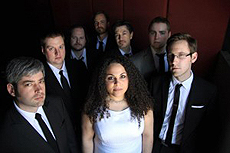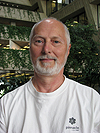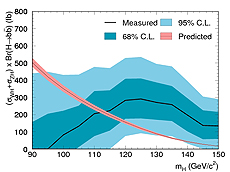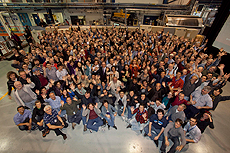|
Have a safe day!
Thursday, July 12
2 p.m.
LHC Physics Center Topic of the Week Seminar - Sunrise, WH11NE
Speaker: Daniel Elvira, Fermilab
Title: SUSY Searches I: Motivation, Physics Objects, Pileup
2:30 p.m.
Theoretical Physics Seminar - Curia II
Speaker: Simone Alioli, Lawrence Berkeley National Laboratory
Title: Next-to-Leading-Order Calculations Merged with Parton Showers
3 p.m.
DIRECTOR'S COFFEE BREAK (NOTE TIME) -
2nd Flr X-Over
3:30 p.m.
Special Joint Experimental-Theoretical Physics Seminar (NOTE DATE, TIME, LOCATION) - Auditorium
Speakers: Bob Hirosky (DZero), University of Virginia
Homer Wolfe (CDF), The Ohio State University
Title: Review of ICHEP 2012 CDF and DZero Results
THERE WILL BE NO ACCELERATOR PHYSICS AND TECHNOLOGY SEMINAR TODAY
Friday, July 13
3:30 p.m.
DIRECTOR'S COFFEE BREAK - 2nd Flr X-Over
4 p.m.
Joint Experimental-Theoretical Physics Seminar - One West
Speaker: Meenakshi Narain, Brown University
Title: New CMS Results at ICHEP
Click here for NALCAL,
a weekly calendar with links to additional information.
Upcoming conferences |
|
Thursday, July 12
- Breakfast: Apple sticks
- Santa Fe black bean soup
- Steak tacos
- Chicken Wellington
- Chimichangas
- Baked ham & Swiss on a ciabatta roll
- Assorted sliced pizza
- Smart cuisine: Crispy fried-chicken salad
Wilson Hall Cafe Menu |
|
Friday, July 13
Dinner
- Insalata caprese on a skewer
- Stuffed flank steak
- Balsamic roasted potatoes
- Chocolate-amaretto soufflé
Wednesday, July 18
Lunch
- Chicken luncheon salad
- Sorbet
Chez Leon Menu
Call x3524 to make your reservation.
|
|
Physicist by day, soul man by night
 |
| Physicist Dan Hooper, left, is a founding member of soul band The Congregation. Photo courtesy of Dan Hooper
|
This Sunday, guitarist Charlie Wayne played for a crowd of about 10,000 with his up-and-coming Chicago soul band. They opened for alt-rockers Wilco at a ballpark outside the city.
The next morning, he went back to his day job at Fermi National Accelerator Laboratory, where he investigates the cosmos – and answers to his given name, Dan Hooper.
For the past seven years, Hooper has been part of the laboratory's theoretical astrophysics group. He has written two books about dark matter, but he typically juggles projects on several subjects at a time. His most recent physics paper dealt with LHC scientists' discovery of a possible Higgs boson.
Hooper found his fascination with physics in college, but he's been playing guitar since he was 15.
"It started as a furious act of rebellion," Hooper said. "I can't think of a better reason to start playing guitar."
Hooper formed a metal band in Cold Spring, Minnesota. At 16, he was playing a regular circuit in bars around the state. Over the past couple of decades, Hooper has played in blues bands, punk bands, an alt-country band and – as a postdoc at the University of Oxford – in a band composed of several astrophysicists and banjo-player Jem Finer of Irish punk band the Pogues.
"By leaps and bounds," none of those groups saw as much success as his current band, The Congregation, he said.
Read more
—Kathryn Jepsen
|
John Urish retires after 40 years at Fermilab
 |
John Urish
|
John Urish has worked for Fermilab for 40 years as a technical specialist and computer specialist. He retires tomorrow.
Urish began work at Fermilab as an electronic hardware technician and, in the 1970s, helped build the electronics for CDF. He later worked as a systems manager for computer-aided design systems, which led to a position as computer specialist in the 1980s. He wrote programs, worked in desktop support, managed servers and, most recently, wrote scripts for use with batch systems.
After retiring, Urish plans to hike, bike and work on his house. He'll also continue to work as a computer specialist, providing support for the November SC12 supercomputing conference in Salt Lake City, Utah.
|
A blip that speaks of our place in the universe
From The New York Times, July 9, 2012
ASPEN, Colo. — Last week, physicists around the world were glued to computers at very odd hours (I was at a 1 a.m. physics "party" here with a large projection screen and dozens of colleagues) to watch live as scientists at the Large Hadron Collider, outside Geneva, announced that they had apparently found one of the most important missing pieces of the jigsaw puzzle that is nature.
The "Higgs particle," proposed almost 50 years ago to allow for consistency between theoretical predictions and experimental observations in elementary particle physics, appears to have been discovered — even as the detailed nature of the discovery allows room for even more exotic revelations that may be just around the corner.
It is natural for those not deeply involved in the half-century quest for the Higgs to ask why they should care about this seemingly esoteric discovery. There are three reasons.
First, it caps one of the most remarkable intellectual adventures in human history — one that anyone interested in the progress of knowledge should at least be aware of.
Read more
|
LUX underground this week
From the Sanford Underground Research Facility's Deep Thoughts, July 9, 2012
On Wednesday the LUX dark-matter detector will begin its complicated two-day journey to the Davis Campus 4,850 feet underground, but work remains to be done.
Today, LUX researchers in the surface lab were preparing for the move—securing detector parts with sturdy plastic ties and wrapping delicate instruments in bubble wrap. The detector itself, enclosed in its double-walled titanium cryostat, was wrapped in pink foam.
Read more
|
|
The Higgs boson: "Two b" or not "two b"
 |
| The best-fit cross section times branching ratio
(σWH + σZH) x Br(H →
bb) as a function of Higgs mass.
The dark-shaded region shows the 68 percent confidence level interval; the light-shaded region shows the 95 percent confidence level region; and the Standard Model prediction is shown as the smooth, falling curve with a narrow band indicating the theoretical uncertainty.
|
With the recent announcement of a new particle discovery by the LHC experiments, it seems very likely that the Higgs boson exists. So, we are finally done with the search for the Higgs boson, right? Not quite!
Now the question is: What kind of a Higgs boson is it? Normally, when physicists talk about the Higgs boson, they are talking about the Standard Model Higgs boson, the simplest mechanism that allows for the masses of the particles in the Standard Model, where "simple" means that the mechanism only requires the Higgs boson - no additional particles required.
For the Standard Model Higgs boson, theorists know how to predict the rate at which it would be produced in a collider experiment and the fraction of the number of times it would decay into each species of other particles. In order to understand whether the Higgs boson is a Standard Model Higgs boson or a Higgs boson related to a more exotic model, scientists must measure as many properties of the Higgs boson as possible.
The excess of Higgs-like events reported by the LHC experiments is primarily due to events in which the boson decays into either two photons or two Z bosons. However, the Higgs boson searches conducted by the Tevatron experiments are more sensitive to the case where the Higgs boson decays into two b quarks.
Recently, the CDF experiment submitted four papers to Physical Review Letters describing searches for the Higgs decay in the bb final state. Scientists search for the cases of the Higgs produced in association with a W boson, the Higgs produced in association with a Z boson, the Higgs produced in association with a W or Z and W/Z decays into invisible particles, and finally a combination of all three searches. The combined result is the most sensitive search to date for the Higgs decaying into two b quarks and, while not conclusive, the result shows slightly stronger hints for the Standard Model than expected. That is, the CDF search for the Higgs boson in the bb final state indicates that it might occur more often than predicted in the Standard Model. However the new result is also still consistent with the Standard Model within measurement uncertainties.
This is an exciting time in the search for the Higgs boson, and it will likely take all of the pieces from the Tevatron and the LHC experiments to complete this challenging puzzle.
—Craig Group
 |
| The CDF collaboration celebrated the Tevatron on September 30, 2011. Photo: Cindy Arnold
|
|
|